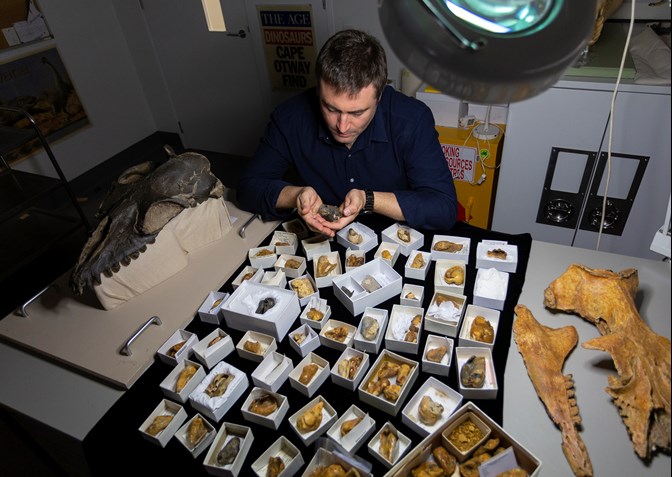Mystery of whale fossil 'dark age' solved in new palaeontology research
New palaeontology research exposes a pivotal turning point in the evolution of baleen whales; the largest animals on earth. Researchers from Museums Victoria, the Royal Belgian Institute of Natural Sciences, and the University of Otago believe they have solved the mystery of a five million year long whale fossil 'dark age'.
The paper, 'Like phoenix from the ashes: how modern baleen whales arose from a fossil "dark age"' was published today in leading international palaeontology journal Acta Pelaeontologica Polonica. Dr Erich Fitzgerald (Museums Victoria), Dr Felix Marx (Royal Belgian Institute of Natural Sciences), and Professor Ewan Fordyce (University of Otago) examined the turning point in the history of baleen whales, which occurred at the boundary of the Oligocene and Miocene epochs (23 million years ago). Their findings tell a powerful story.
The Golden Age
The baleen whale group (Mysticeti or mysticetes) includes the living Blue, Humpback, and Minke whales. These enormous, toothless mammals use a comb-like keratinous filter (baleen) to strain small prey from seawater. Yet these giants of the deep were not always so toothless, giant, or confined to the deep. During the Oligocene (34 to 23 million years ago) there lived both toothless and toothed species. Bizarre, miniature species of toothed baleen whales (2-4 metres long) evolved to inhabit shallow, coastal regions. The larger, familiar-looking toothless baleen whale species mostly inhabited deeper offshore environments.
The Dark Age
23 million years ago, the baleen whale golden age ended abruptly. Rapid cooling occurred across earth's oceans, causing ice sheets to form and global sea-levels to drop by 40 metres. Once-rich shallow coastal sea environments dried up, destroying the habitat of the tiny primitive toothed baleen whales, causing what the paper's authors term a 'Global Whale Crisis' (GWC). As a result, the coastal species of baleen whale vanished, leaving predominantly shallow water marine deposits across the planet devoid of baleen whale fossils for five million years.
The Renaissance
A baleen whale renaissance suddenly occurred 18 million years ago. Descendents of the offshore, deeper water baleen whales suddenly repopulated shallow coastal waters (and the fossil record) thanks to warmer seas and rising sea levels. Yet only the toothless baleen whales re-emerged; toothed mysticetes had gone entirely extinct. The research suggests that this extinction was a result of eradication of their close-to-shore environments. Only their larger, toothless cousins survived in their deeper water habitats for millions of years.
The fossils used to conduct the case study are exceptionally unassuming; difficult to spot earbones (tympanic bullae) of baleen whales. More than 100 of these small, usually sandy-coloured and sometimes shell-shaped fossils were examined. Collected by experts and dedicated members of the public at various sites in southern New Zealand and Victoria, many were discovered at familiar Victorian locations near Torquay and Geelong.
Dr Fitzgerald acknowledges that, based on all of this, it's tempting to speculate that warmer, higher sea levels could promote global whale abundance. However, he cautions against using past patterns to predict the future. Our rapidly changing world is vastly different to that of 25 million years ago. The future of many whale species is uncertain, with ongoing environment disruptions presenting challenges to the survival of many whale species. The fate of the mini, toothed baleen whales sounds a warning across millions of years.
Media kit contents:
- Media release
- Hi-res images
- Audio grabs: Dr Fitzgerald explaining the paper's findings
- Research paper
- Biography of Dr Erich Fitzgerald
Interviews available with Dr. Erich Fitzgerald, Senior Curator of Vertebrate Palaeontology, Museums Victoria.









